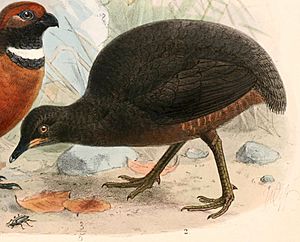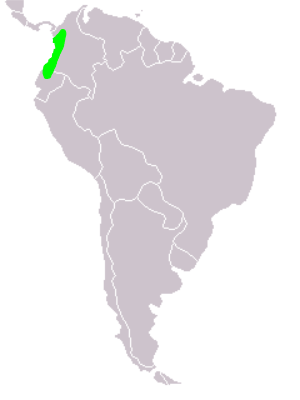Berlepsch's tinamou facts for kids
Quick facts for kids Berlepsch's tinamou |
|
|---|---|
 |
|
| Berlepsch's tinamou is the bird in the center. The bird on the left is another species. | |
| Conservation status | |
| Scientific classification | |
| Genus: |
Crypturellus
|
| Species: |
berlepschi
|
 |
|
The Berlepsch's tinamou (Crypturellus berlepschi) is a special kind of bird that lives on the ground. You can find it in the wet, green forests of northwestern Colombia and northwestern Ecuador. It's a bit like a chicken but with some unique features!
Contents
About the Berlepsch's Tinamou
The Berlepsch's tinamou is a unique bird. It's the only species of its kind in the Crypturellus group that looks exactly like this. All tinamous belong to the family called Tinamidae. They are also part of a larger group of birds known as ratites.
What Makes Tinamous Special?
Most ratites, like ostriches or emus, cannot fly. But tinamous are different! They can fly, even though they are not super strong fliers. Scientists believe that all ratites came from ancient birds that could fly. Tinamous are the closest living relatives to these prehistoric flying birds.
For a long time, people thought the Berlepsch's tinamou was just a type of cinereous tinamou. But then, scientists looked closely at its beak size. They also measured its toes and legs. They saw that its feathers looked very different from the cinereous tinamou. Because of these differences, they decided it was a completely new species!
What's in a Name?
The scientific name for this bird is Crypturellus berlepschi. Let's break down what that means!
Meaning of Crypturellus
The word Crypturellus comes from three old words:
- kruptos (Greek) means covered or hidden.
- oura (Greek) means tail.
- ellus (Latin) means small or diminutive.
So, Crypturellus means "small hidden tail." This is because the tinamou's tail is quite small and often hidden by its feathers.
Meaning of berlepschi
The second part of the name, berlepschi, is a tribute. It's named after a German bird expert and collector named Hans von Berlepsch.
What Does It Look Like?
The Berlepsch's tinamou is a medium-sized bird. It grows to be about 29.6–32 centimetres (11.7–12.6 in) long.
Size and Weight
- Male tinamous weigh around 430–537 grams (15.2–18.9 oz).
- Female tinamous are a bit heavier, weighing about 512–615 grams (18.1–21.7 oz).
Feathers and Colors
The feathers of this bird can vary a little. But generally, they are a brownish-black color. Sometimes they are a very deep, smoky brown.
- Its head and throat are usually darker than the rest of its body.
- The top of its head and the back of its neck might have a reddish tint.
- Its legs and feet are pink.
- Its beak has a dark upper part and a pinkish lower part. This beak is longer and heavier than the cinereous tinamou's beak.
- Its eyes (iris) are red.
Young Birds
Young Berlepsch's tinamous look similar to the adults. However, they have stripes on their undersides and wings. These stripes might have a cinnamon color.
Where Does It Live?
The Berlepsch's tinamou lives in a specific area. You can find it in the very northern coastal parts of Ecuador. From there, its home stretches north into the coastal areas of Colombia. It goes as far north as Utria National Park in Colombia.
Habitat Choices
This tinamou prefers to live in lowland moist forests. These are forests in warm, tropical or subtropical regions. It also likes to live in older secondary forests, which are forests that have grown back after being cut down. This bird can even survive in forests that have been logged, meaning trees have been cut down.
In Colombia, it lives in coastal lowlands and hills up to 500 metres (1,600 ft) high. Sometimes, it has been found even higher, up to 900 metres (3,000 ft).
Known Sightings
Scientists have recorded only two specific sightings of this bird:
- At Playa de oro reserva de los tigrillos in Ecuador. This spot is about 20 kilometres (12 mi) north of the Cotacachi Cayapas Ecological Reserve.
- At Milipe Bird Sanctuary, also in Ecuador. This sanctuary is about 15 kilometres (9.3 mi) west of Maquipucuna.
How Does It Behave?
The Berlepsch's tinamou is known as a "sedentary" bird. This means it doesn't move around much or migrate to different places. It tends to stay in one area.
What Does It Eat?
Scientists don't have a lot of specific information about what the Berlepsch's tinamou eats. But they believe it eats similar things to other birds in the Crypturellus group.
- Its main food is fleshy fruit. It likes to eat fruit that has fallen on the ground.
- It will also pick fruit from lower branches.
- Like other tinamous, it eats small amounts of invertebrates (like insects), flower buds, soft leaves, seeds, and roots.
How Does It Raise Its Young?
Berlepsch's tinamous breed in February in Colombia. Since they live in forests, they choose months when there is plenty of food, which is usually during the summer.
The male tinamou has a very important job. Like other tinamous, the male sits on the eggs to keep them warm. These eggs might come from as many as four different females! After the eggs hatch, the male takes care of the young birds until they are ready to live on their own. This usually takes about two to three weeks.
The nest is built on the ground. It's often hidden in thick bushes or between the raised roots of trees.
Is It Endangered?
The IUCN (International Union for Conservation of Nature) keeps track of how many animals are left in the wild. They classify the Berlepsch's tinamou as "Least Concern". This means there are still enough of these birds around that they are not currently at risk of disappearing. Its habitat covers a large area of about 60,000 km2 (23,000 sq mi).
See also
 In Spanish: Tinamú tizón para niños
In Spanish: Tinamú tizón para niños


